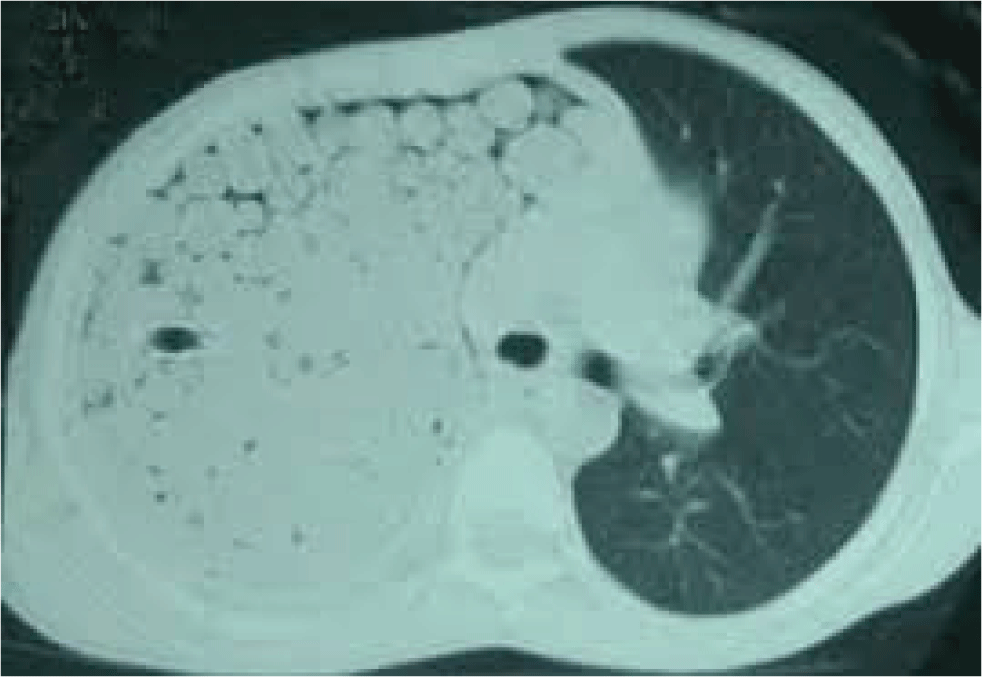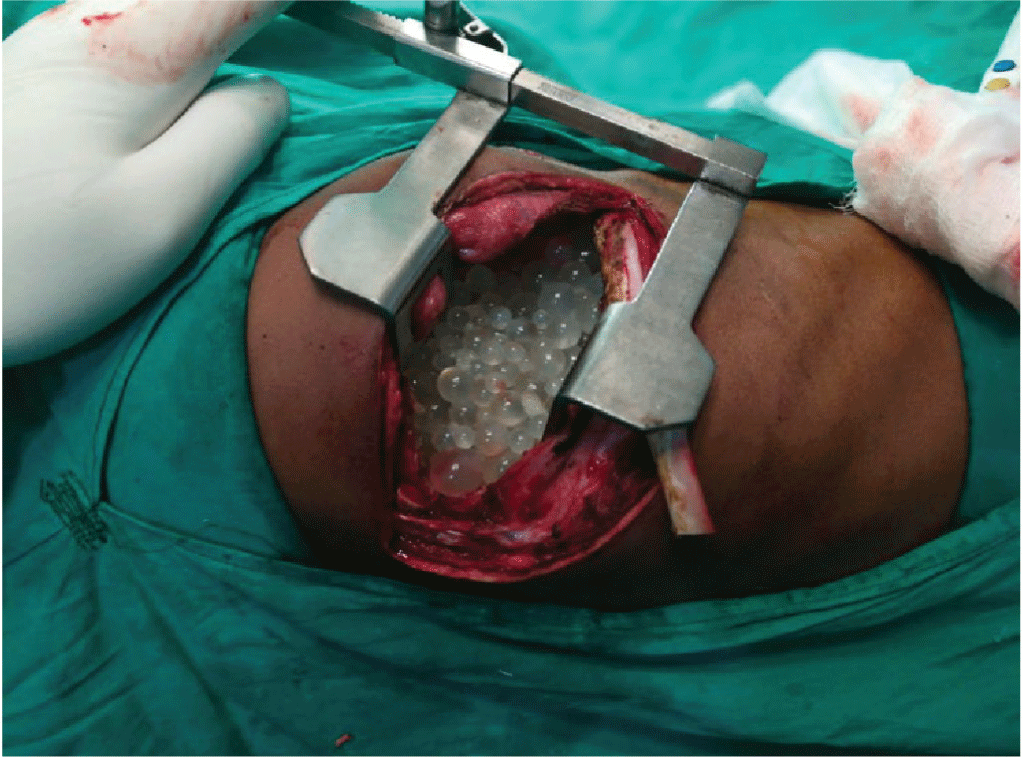1. BACKROUND
Human hydatid disease or cystic echinococcus is a parasitic infestation caused by the larval form of the tapeworm Echinococcus granulosus, which lives in intestines of dogs and other canines. Ingestion of feces contaminated with parasite eggs causes liberation of larvae in the duodenum of intermediate hosts which can be sheep, goat, reindeer or human. The analysis of recent medical literature reveals that the incidence of hydatid disease has increased worldwide especially in tropical countries [1]. Therefore, the World Health Organization (WHO) has declared it as the most neglected tropical disease [2]. This zoonotic disease is more prevalent in sheep-raising areas like the Mediterranean countries, South America, northern China, the Middle East and India [3]. The liver is the most commonly involved site (75%), followed by the lungs (15%), spleen (5%), and other organs (5%) [3]. The authors present a case of intrapleural hydatid cyst which was solely confined to the pleural space sparing the lung parenchyma and other associated structures.
2. CASE PRESENTATION
A 10-year-old male presented to the local basic health unit of Dera Ismail Khan, Pakistan. His chief complaints were exacerbating severe chest pain associated with high-grade fever and dyspnea. In addition, he complained of shortness of breath, dry cough and vague chest pain that developed over the last three months. Initially, his symptoms were mild but progressively worsened over time. The patient also reported appetite loss, without any other complaint such as palpitations, nausea, jaundice, or vomiting. There was no history of change in bowel habits or urinary symptoms. The patient was living in a rural area and he had a history of long-term exposure to domestic pets. He did not undergo any kind of surgery in the past.
At the time of presentation, the patient was hemodynamically unstable with a pulse rate of 108 beats per minute, blood pressure of 100/80 mmHg and an oral temperature of 39°C. The patient was tachypnic with a respiratory rate of 26 breaths per minute. Chest movements and breath sounds were decreased on the right side with a dull percussion present in comparison to left hemithorax examination. There were no additional breath sounds. Chest X-ray was ordered which revealed right-sided lung white-out with contralateral mediastinal shift. The physician at the local health facility diagnosed it as pyothorax and placed a chest drainage tube on the right side. Nevertheless, two weeks after the placement of right-sided tube thoracostomy the condition of the patient did not improve. Subsequently, he was referred to the Department of Thoracic Surgery, Nishter Medical University Hospital, Multan Pakistan, for further evaluation and management. The patient was thoroughly re-assessed. Table 1 describes the laboratory results of baseline investigations.
A chest CT scan was also ordered, showing multiple cysts occupying the whole intrapleural space on the right side and completely compressing the right lung. Fig. 1 shows the chest CT scan of the patient revealing a large mother hydatid cyst.

The mother hydatid cyst also contained numerous daughter cysts of variable size occupying the whole pleural space on right side. Based on chest X-ray and CT scan findings, a suspicion of intrapleural hydatid disease was made. The patient underwent right posterolateral thoracotomy. The right-sided pleural cavity was obliterated by a large mother hydatid cyst containing multiple daughter hydatid cysts. In addition, the right lung was totally collapsed due to the compressive effect applied by the multilocular cystic mass. Intraoperatively, the evacuation of cysts content resulted in immediate lung expansion and no other abnormality or defect was identified in the lung parenchyma. Fig. 2 depicts the intra-operative findings of this case where numerous daughter cysts are rushing out from the thoracotomy site.

The wound and pleural cavity were irrigated with normal saline and the collapsed lung was adequately infl via the assistance of positive pressure ventilation. The patient had an uneventful recovery and was discharged from the hospital three days postoperatively. The patient did not have any air leakage through the chest tubes during his post-operative course, confi the non-involvement of lung parenchyma. He was consequently followed up at the intervals of one week, one month and six months. During all these visits the patient remained asymptomatic and chest X-ray performed at the follow-up visits showed bilaterally normal lungs. All these events are summarized in table 2 in their chronological order.
3. DISCUSSION
Hydatid disease has become an increasingly emerging public health problem in Pakistan. However, the medical literature from Pakistan is quite scant and does not address this issue adequately. A recent study by Ahmad et al claims that between 1980 and 2015, only three research papers on the prevalence of hydatid disease and 13 case reports about the involvement of unusual body locations by hydatid cysts were published [4]. The clinical presentation of disease correlates with the involvement of particular organs and adjacent structures. Pezeshki et al stated the relative frequency of different unusual sites of hydatid cysts such as spleen (7.69 %), abdomen (3.84 %), spinal cord (2.56 %), sub-diaphragmatic space (1.28 %), peritoneum (1.28 %), kidney (1.28 %) and pancreas (1.28 %) [5]. The extra-pulmonary, intrapleural hydatid disease is a rare clinical entity even in endemic countries, though the pleural cavity is not completely immune to Hydatid disease. Thameur H, et al. in their review of 1,619 cases, found 42 cases of intrathoracic extra-pulmonary hydatid disease. Furthermore, out of the aforementioned 42 cases, only 22 were primary intra-pleural hydatid cysts [6]. An Indian study by Srinivasan B et al reports that out of 127 cases only 4 were extrapulmonary and intrapleural [7]. Nevertheless, we could not identify any study from Pakistan reporting extra-pulmonary intrapleural hydatid cysts sparing the lung parenchyma. It is important to note that in the case of primary pleural hydatid cyst disease, the larvae infest the pleura either through hematogenous or lymphogenous spread. However, in secondary pleural hydatid cysts, the primary nidus of infection is usually the hepatic and pulmonary parenchyma hydatid cyst which ruptures in the pleural space [8]. It is worth mentioning that in our case the pleral cavity was primary affected without hepatic or pulmonary involvement.
The clinical features of hydatid cyst depend upon the extent of the parasitic infestation, size of cystic mass and the organ involved. Our patient presented with the classical features of cough, chest pain and shortness of breath. In addition, he did not complain of hemoptysis. Sarkar M et al. pointed out hemoptysis as the predominant clinical feature in adult patients affected by hydatid disease. In contrast to the adult population, hemoptysis is usually absent in pediatric patients [9]. Interestingly, our case had a high-grade fever with rigor and chills. Conversely, Mardani P et al. reported the presence of low-grade fever in their study [10]. The likely reason for this unusual high-grade fever in our case might be the superadded bacterial infection.
Emlik D et al. described the classification of various subtypes of Hydatid cyst on the basis of radiological findings. According to this classification system, our case belongs to type 2 hydatid cyst, as the chest computed tomography revealed a large mother hydatid cyst containing multiple daughter cysts of variable size. Furthermore, in the presented case, complete blood count showed eosinophilia, a finding highly suggestive of parasitic infestation and compatible with our diagnosis. Conversely, the liver function tests were within the normal range because liver and biliary tract were not affected by the disease. Despite being a very non-specific investigation finding, the CRP levels were raised, indicating a possible infectious etiology. This was an additional clue pointing towards our diagnosis. In addition, anti-hydatid IgG antibodies also came positive, suggesting the presence of hydatid disease. This finding was consistent with a previous study by Zaman K et al. reporting that all the confirmed cases of hydatid disease were seropositive for anti-hydatid IgG antibodies. Hence, in cases of hydatid disease involving an unusual site such as the pleural space, a strong clinical suspicion, supportive radiological findings, and positive serological evidence play a critical role in the establishment of diagnosis [8, 9]. Detecting anti-Hydatid IgG antibodies by ELISA is considered a sensitive test that can be used as the initial screening process [9]. Considering the available treatment options, surgical removal is the standard of care for hydatid disease. However, some authorities suggest the use of percutaneous drainage of echinococcal cysts (PAIR-puncture, aspiration, injection of hypertonic saline, re-aspiration with chemotherapy) [10]. In unfit or inoperable cases, albendazole can be used as alternative medical therapy [8]. In summary, the clinicians should be aware that vague chest pain associated with shortness of breath and cough can be a clinical presentation of primary intrapleural hydatid disease.
4. CONCLUSION
The pleural space is an atypical location of hydatid disease and is rarely affected even in endemic countries. Diagnosis is based on strong clinical suspicion, imaging findings, and positive serological evidence. This case report raises awareness about the possibility of intrapleural hydatid disease presence in a patient presenting with appropriate clinico-radiological findings and notifies that concomitant lung parenchymal involvement is not essential.








